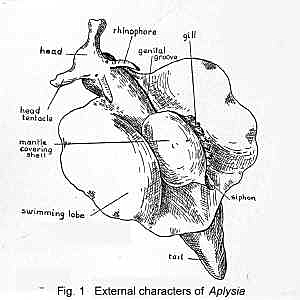|
< Previous family introduction |
|
|||||
|
Family Aplysiidae Sea Hares
|
||||||
|
The Aplysiidae, commonly known as sea hares, not because of their speed of movement but apparently because of their resemblance to a sitting hare, are large, soft-bodied animals that graze on algae intertidally and in the shallow subtidal. Most have a flattish, irregularly shaped internal shell, reducing to a vestigial wedge or no shell at all in some species. The body size ranges from 10-750 mm in length, making the large individuals among the most spectacular animals on NSW shores. Sea hares move by creeping on the substrate, and some swim by flapping their parapodia. They live in open situations, defending themselves from predators by toxins in the skin and by ejecting a cloud of noxious purple or milky fluid. Their colour is variable, being derived from the algae they eaten More than 20 species of sea hare are known from Australia, with at least 16 from NSW (See Coverage below). At least three species have a circum-global distribution in tropical and temperate waters. Five species are considered to be endemic to Australia, while others are distributed throughout the Indo-West Pacific region. At least five species extend as far south as Tasmania. The external morphology of an Aplysia sea hare is shown in Fig. 1. The head bears head tentacles as well as chemosensory rhinophores, with eyes at their base. The lateral extensions of the foot labelled as swimming lobes, (or parapodia) are used for swimming by flapping up and down. The shell is covered by a thin layer of mantle tissue, and is small compared to the size of the animal. The gill is located below and to the right of the shell, which provides some protection for it.
Family References: Bebbington, A. 1977 Aplysiid species from eastern Australia with notes on the Pacific Ocean Aplysiomorpha (Gastropoda: Opisthobranchia) Transactions of the Zoological Society of London 34: 87-147. Gosliner, T.M., Valdés, A. & Behrens, D.W. 2015. Nudibranch & Sea Slug Identification Indo-Pacific. New World Publications: Jacksonville, Florida. Coverage Only one species of Aplysiida from NSW is detailed here. There are 16 species of the family recorded from NSW, as listed below. Except for species of Bursatella and Stylocheilus they have partially or completely enclosed shells.
|
